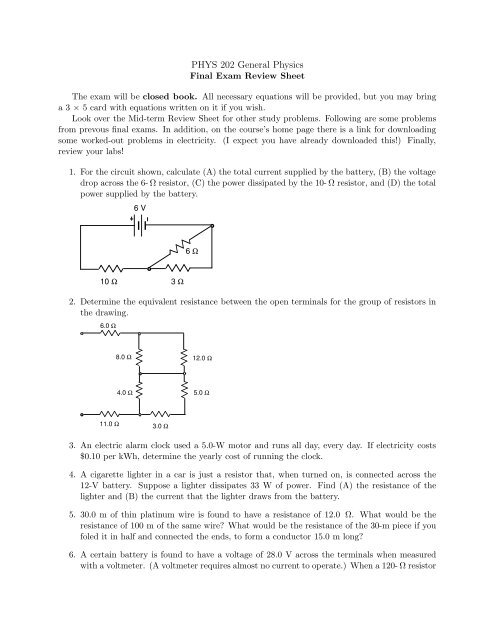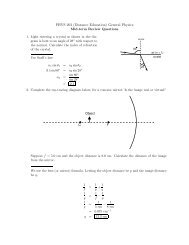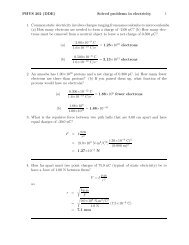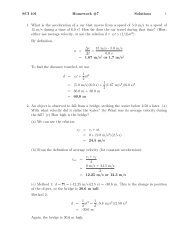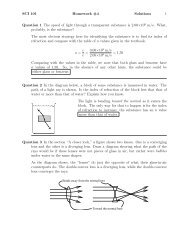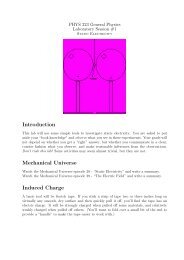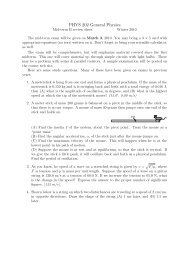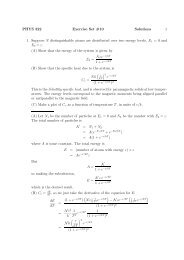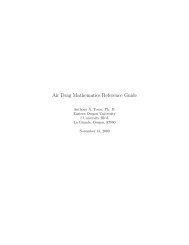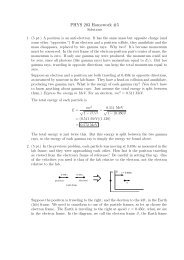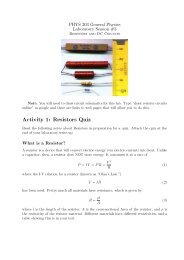PHYS 202 General Physics
PHYS 202 General Physics
PHYS 202 General Physics
You also want an ePaper? Increase the reach of your titles
YUMPU automatically turns print PDFs into web optimized ePapers that Google loves.
<strong>PHYS</strong> <strong>202</strong> <strong>General</strong> <strong>Physics</strong><br />
Final Exam Review Sheet<br />
The exam will be closed book. All necessary equations will be provided, but you may bring<br />
a 3 × 5 card with equations written on it if you wish.<br />
Look over the Mid-term Review Sheet for other study problems. Following are some problems<br />
from prevous final exams. In addition, on the course’s home page there is a link for downloading<br />
some worked-out problems in electricity. (I expect you have already downloaded this!) Finally,<br />
review your labs!<br />
1. For the circuit shown, calculate (A) the total current supplied by the battery, (B) the voltage<br />
drop across the 6- Ω resistor, (C) the power dissipated by the 10- Ω resistor, and (D) the total<br />
power supplied by the battery.<br />
6 V<br />
6 Ω<br />
10 Ω 3 Ω<br />
2. Determine the equivalent resistance between the open terminals for the group of resistors in<br />
the drawing.<br />
6.0 Ω<br />
8.0 Ω<br />
12.0 Ω<br />
4.0 Ω<br />
5.0 Ω<br />
11.0 Ω<br />
3.0 Ω<br />
3. An electric alarm clock used a 5.0-W motor and runs all day, every day. If electricity costs<br />
$0.10 per kWh, determine the yearly cost of running the clock.<br />
4. A cigarette lighter in a car is just a resistor that, when turned on, is connected across the<br />
12-V battery. Suppose a lighter dissipates 33 W of power. Find (A) the resistance of the<br />
lighter and (B) the current that the lighter draws from the battery.<br />
5. 30.0 m of thin platinum wire is found to have a resistance of 12.0 Ω. What would be the<br />
resistance of 100 m of the same wire What would be the resistance of the 30-m piece if you<br />
foled it in half and connected the ends, to form a conductor 15.0 m long<br />
6. A certain battery is found to have a voltage of 28.0 V across the terminals when measured<br />
with a voltmeter. (A voltmeter requires almost no current to operate.) When a 120- Ω resistor
is connected across the terminals of the battery, the voltage drop across the resistor is found<br />
to be 25.5 V. Determine the internal resistance of the battery. Predict what the voltage<br />
between the battery terminals would be if we hooked a 40- Ωresistor between the terminals.<br />
7. Why can a bird sit on a high-voltage power line and not be shocked<br />
8. Here is drawn a circuit involving a battery and a light bulb. What will happen if we “ground”<br />
a terminal of the light bulb by hooking to a metal pipe stuck in the ground Explain.<br />
PIPE<br />
9. Consider the circuit below. When the resistance of the nichrome wire is decreased, what<br />
happens to the brightness of each bulb Explain why this happens, using concepts of both<br />
current and voltage.<br />
A<br />
+<br />
-<br />
3 V<br />
B<br />
Nichrome<br />
wire<br />
10. In the circuit shown below, the voltage across the 30- Ω resistor is 2.40 volts. Find the battery<br />
voltage without calculating any currents.<br />
10 Ω<br />
+<br />
V = <br />
-<br />
30 Ω<br />
60 Ω<br />
5 Ω<br />
#1: (A) 0.5 A (B) 1.0 V (C) 2.5 W (D) 3.0 W<br />
#2: 24.5 Ω<br />
#3: $4.38<br />
#4: 4.4 Ω, 2.8 A<br />
#5: 3 Ω<br />
#6: 11.8 Ω, 21.6 V<br />
#9: 4.20 volts


